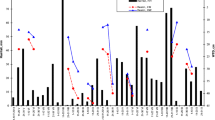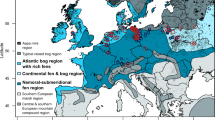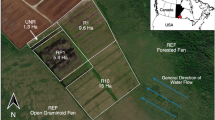Abstract
Several studies contributed to the development of restoration techniques for open Sphagnum-dominated habitats on peat-extracted bogs. Yet, in exception to some afforestation efforts, connectivity between restored sites and surrounding landscapes has received little attention. The general goal of this study is to ameliorate management of very shallow peat fields (<30 cm) located within the margins of peat-extracted bogs. Firstly, to assist decision making in peatland management, baseline ecological conditions, peat physicochemistry and spontaneous vegetation recolonization were assessed for 18 of these fields. This first study revealed that (1) concentrations of several macro-nutrients are almost one order of magnitude lower for unrestored fields than previously characterized natural lagg habitats of the same region, and (2) there is little spontaneous colonization. In a second study, peat chemistry and soil/air microclimate were evaluated in plantations established on shallow residual peat (a 21-year-old Larix laricina plantation and an 18-year-old Picea mariana plantation) and compared to adjacent unrestored shallow bare-peat fields. This second study showed that afforested peat fields are characterized by (1) a soil enriched in nutrients, notably in N, P, and K, and (2) a more humid and cooler microclimate at the soil/air interface, with less daily humidity and temperature fluctuations. These results indicate that afforestation is an appropriate approach to start an ecological recovery. Yet, the absence of natural recolonization by herbs and mosses in the understory of afforested peat fields suggests that reintroduction of appropriate understory species should also be considered if the goal is to restore a fully functional ecosystem.




Similar content being viewed by others
References
Allen JA, Keeland BD, Stanturf JA, Clewell AF, Kennedy HE Jr (2004) A guide to bottomland hardwood restoration. US Geol Surv 12(4):525–532
Andersen R, Rochefort L, Landry J (2011) La chimie des tourbières du Québec: une synthèse de 30 années de données. Nat Can 135:5–14
Aro L, Kaunisto S (1998) Nutrition and development of 7–17–year old scots pine and silver birch plantations in cutaway peatlands. In: Malterer T, Johnson K, Stewart J (eds) Peatland restoration and reclamation: techniques and regulatory considerations. Proceedings of the 1998 International Peat Symposium, Duluth, pp 109–114
Atkinson RB, Perry JE, Cairns J Jr (2005) Vegetation communities of 20-year-old created depressional wetlands. Wetl Ecol Manag 13:469–478
Aussenac G (2000) Interaction between forest stands and microclimate: ecophysiological aspects and consequences for silviculture. Ann For Sci 57:287–301
Bachmann RW, Hoyer MV, Canfield DE Jr (1999) The restoration of Lake Apopka in relation to alternative stable states. Hydrobiologia 394:219–232
Barry WJ, Garlo AS, Wood CA (1996) Duplicating the mound-and-pool microtopography of forested wetlands. Restor Manag Notes 14:15–21
Bell SS, Fonseca MS, Motten LB (1997) Linking restoration and landscape ecology. Restor Ecol 5:318–323
Berthrong ST, Jobbágy EG, Jackson RB (2009) A global meta-analysis of soil exchangeable cations, pH, carbon, and nitrogen with afforestation. Ecol Appl 19:2228–2241
Bourgeois B, Hugron S, Poulin M (2012) Establishing a moss cover inhibits the germination of Typha latifolia, an invasive species, in restored peatlands. Aquat Bot 100:76–79
Bray RH, Kurtz LT (1945) Determinations of total, organic and available forms of phosphorus in soils. Soil Sci 59:39–45
Buck G (2003) Pit and mound restoration: when a tree falls. In: Lemieux CJ, Gordon Nelson J, Beechey TJ, Troughton MJ (eds) parks research forum of ontario (PRFO) 2003 Proceedings, University of Ontario, 8–10 May 2003, pp 385–389
Bussières J, Boudreau S, Rochefort L (2008) Establishing trees on cut-over peatlands in eastern Canada. Mires Peat 3(10):1–12
Caisse G, Boudreau S, Munson A, Rochefort L (2008) Fertiliser addition is important for tree growth on cut-over peatlands in eastern Canada. Mires Peat 3(11):1–15
Campbell DR, Rochefort L, Lavoie C (2003) Determining the immigration potential of plants colonizing disturbed environments: the case of milled peatlands in Québec. J Appl Ecol 40:78–79
Chapin FS III (1980) The mineral nutrition of wild plants. Annu Rev Ecol Syst 11:233–260
Chimner RA, Hart JB (1996) Hydrology and microtopography effects on northern white-cedar regeneration in michigan’s Upper Peninsula. Can J Forest Res 26:389–393
Ehrenfeld JG (1995) Microsite differences and surface substrate characteristics in Chamaecyparis swamps of the New Jersey Pinelands. Wetlands 15:183–189
Ehrenfeld JG, Toth LA (1997) Restoration ecology and the ecosystem perspective. Restor Ecol 5:307–317
Environment Canada (2012) National climate data and information archive. http://climate.weatheroffice.gc.ca/climateData/canada_e.html
Fontaine N, Poulin M, Rochefort L (2007) Plant diversity associated with pools in natural and restored peatlands. Mires and Peat 2. http://www.mires-and-peat.net/map02/map_02_06.pdf
Golet FC, Calhoun AJK, DeRagon WR, Lowry DJ, Gold AJ (1993) Ecology of red maple swamps in the glaciated Northeast: a community profile. Biological Report 12. US Fish and Wildlife Service, Washington
González E, Rochefort L, Boudreau S, Hugron S, Poulin M (2013) Can indicator species predict restoration outcomes early in the monitoring process? A case study with peatlands. Ecol Indic 32:232–238
Graf MD, Rochefort L (2016) A conceptual framework for ecosystem restoration applied to industrial peatlands. In: Bonn A, Allott T, Evans M, Joosten H, Stoneman R (eds) Peatland restoration and ecosystems services: science, policy and practice. Ecological Reviews of Cambridge University Press, Cambridge, pp 192–213
Graf MD, Rochefort L, Poulin M (2008) Spontaneous revegetation of cutaway peatlands of North America. Wetlands 28:28–39
Grand-Clement E, Anderson K, Smith D, Angus M, Luscombe DJ, Gatis N, Bray LS, Brazier RE (2015) New approaches to the restoration of shallow marginal peatlands. J Environ Manag 161:417–430
Groeneveld EVG, Rochefort L (2005) Polytrichum strictum as a solution to frost heaving in disturbed ecosystems: a case study with milled peatlands. Restor Ecol 13:74–82
Grygoruk M, Batelaan O, Mirosław-Świątek D, Szatyłowicz J, Okruszko T (2014) Evapotranspiration of bush encroachments on a temperate mire meadow—a nonlinear function of landscape composition and groundwater flow. Ecol Eng 73:598–609
Hart SA, Chen HYH (2006) Understory vegetation dynamics of North American boreal forests. Crit Rev Plant Sci 25:381–397
Hillel D (1998) Environmental soil physics. Academic Press, San Diego
Hinds HR (2000) The flora of New Brunswick: a manual for the identification of the vascular plants of New Brunswick. University of New Brunswick, Fredericton
Hobbs RJ (2007) Setting effective and realistic restoration goals: key directions for research. Restor Ecol 15:354–357
Holmgren M, Scheffer M, Huston MA (1997) The interplay of facilitation and competition in plant communities. Ecology 78:1966–1975
Hovick SM, Reinartz JA (2007) Restoring forest in wetlands dominated by reed canarygrass: the effects of pre-planting treatments on early survival of planted stock. Wetlands 27:24–39
Howie SA, Tromp-van Meerveld I (2011) The essential role of the lagg in raised bog function and restoration: a review. Wetlands 31:613–622
Hugron S, Bussières J, Rochefort L (2013) Tree plantations within the context of ecological restoration of peatlands: a practical guide. Peatland ecology research group, Université Laval, Québec. http://www.gret-perg.ulaval.ca. Accessed 16 Jun 2016
Jobbágy EG, Jackson RB (2004) The uplift of soil nutrients by plants: biogeochemical consequences across scales. Ecology 85:2380–2389
Jutras S, Plamondon AP, Hökkä H, Begin J (2006) Water table changes following precommercial thinning on post-harvest drained wetlands. For Ecol Manag 235:252–259
Kangas L (2012) Restoration of forest wetlands: case studies in Michigan and Finland, dissertation. University of Helsinki, Finland
Kellman M, Kading M (1992) Facilitation of tree seedling establishment in a sand dune succession. J Veg Sci 3:679–688
Kelly EF, Chadwick OA, Hilinski TE (1998) The effect of plants on mineral weathering. Biogeochemistry 42:4–139
Lajoie J (2015) Le Scirpus cyperinus: germination, établissement et compétition en contexte de restauration de fen. M.Sc Thesis, Université Laval, Québec, 60 p
Legendre P, Legendre L (2012) Numerical ecology, 3rd edn. Elsevier, Amsterdam
Lieffers VJ, Macdonald SE (1993) Ecology of and control strategies for Calamagrostis canadensis in boreal forest sites. Can J Forest Res 23:2070–2077
Lieffers VJ, Rothwell RL (1986) Effects of water table and substrate temperature on root and top growth of Picea mariana and Larix laricina seedlings. Can J Forest Res 16:1201–1206
Limpens J, Holmgren M, Jacobs CMJ, Van der Zee SEATM, Karofeld E, Berendse F (2014) How does tree density affect water loss of peatlans? A mesocosm experiment. PLoS One 9(3):e91748. doi:10.1371/journal.pone.0091748
MacDonald SE, Lieffers VJ (1990) Photosynthesis, water relations, and foliar nitrogen of Picea mariana and Larix laricina from drained and undrained peatlands. Can J Forest Res 20:995–1000
MacKay RM, Reid S, William R, Hill NM (2010) Genetic evidence of introgressive invasion of the globally imperiled Scirpus longii by the weedy Scirpus cyperinus (Cyperaceae) in Nova Scotia. Rhodora 112:34–57
Malloy S, Price JS (2014) Fen restoration on a bog harvested down to sedge peat: a hydrological assessment. Ecol Eng 64:151–160
Paavilainen E, Päivänen J (1995) Peatland forestry: ecology and principles. Ecological studies, vol 111. Springer, Berlin, pp 109–117
Paradis É, Rochefort L, Langlois M (2015) The lagg ecotone: an integrative part of bog ecosystems in North America. Plant Ecol 216:999–1018
Price JS, Rochefort L, Quinty F (1998) Energy and moisture considerations on cutover peatlands: surface microtopography, mulch cover and Sphagnum regeneration. Ecol Eng 10:293–312
Renou F, Farrell EP (2005) Reclaiming peatlands for forestry: the Irish experience. In: Stanturf JA, Madsen P (eds) Restoration of boreal and temperate forests. CRC Press, London, pp 541–557
Renou-Wilson F, Keane M, Farrell EP (2008) Establishing oak woodland on cutaway peatlands: effects of soil preparation and fertilization. For Ecol Manag 255:728–737
Renou-Wilson F, Pöllänen M, Byrne K, Wilson D, Farrell EP (2010) The potential of birch afforestation as an after use option for industrial cutaway peatlands. Suo 61:59–76
Rezanezhad F, Andersen R, Pouliot R, Price JS, Rochefort L, Graf MD (2012) How fen vegetation structure affects the transport of oil sands process-affected waters. Wetlands 32:557–570
Rochefort L, Bastien D (1998) Réintroduction de sphaignes dans une tourbière exploitée: évaluation de divers moyens de protection contre la dessication. Écoscience 5:117–127
Rochefort L, Lode E (2006) Restoration of degraded boreal peatlands. In: Kelman WR, Vitt DH (eds) Boreal peatland ecosystems, Springer. Berlin. http://www.springerlink.com/index/10.1007/978-3-540-31913-9_17. Accessed 16 Jun 2016
Seastedt TR, Hobbs RJ, Suding KN (2008) Management of novel ecosystems: are novel approaches required? Front Ecol Environ 6:547–553
Simmons ME, Wu XB, Whisenant SG (2011) Plant and soil responses to created microtopography and soil treatments in bottomland hardwood forest restoration. Restor Ecol 19:136–146
Sun G, McNulty SG, Shepard JP, Amatya DM, Riekerk H, Comerford NB (2001) Effects of timber management on the hydrology of wetland forests in the southern United States. For Ecol Manag 143:227–236
R development core team (2008) R: a language and environment for statistical computing. R foundation for statistical computing. http://www.R-project.org. Accessed 16 Jun 2016
The ecosystem classification working group (TECWG) (2007) Our landscape heritage: the story of ecological land classification in New Brunswick, Second edition. Department of natural resources, New Brunswick, Fredericton, Canada. http://www2.gnb.ca/content/gnb/en/departments/natural_resources/ForestsCrownLands/content/ProtectedNaturalAreas/OurLandscapeHeritage.html. Accessed 16 Jun 2016
Titus JH (1990) Microtopography and woody plant regeneration in a hardwood floodplain swamp in Florida. B Torrey Bot Club 117:429–437
Whitelaw G, Hubbard P, Mulamoottil G (1989) Restoration of Swampland: planning guidelines and recommendations. Can Water Resour J 14:1–9
Wind-Mulder HL, Rochefort L, Vitt DH (1996) Water and peat chemistry comparisons of natural and post-harvested peatlands across Canada and their relevance to peatland restoration. Ecol Eng 7:161–181
Acknowledgments
Financial support for this research was provided by the Natural Sciences and Engineering Research Council of Canada, the Ministry of Natural Resources and Energy of New Brunswick, and the Canadian Sphagnum Peat Moss Association and its members. Personal grants to Étienne Paradis were provided by the Fonds québécois de recherches sur la nature et les technologies and Institut Hydro-Québec en Environnement, Développement et Société. We are particularly grateful to Phan Cat Tuong Le and Catherine Emond for assistance in the field. We also thank members of the Peatlands Ecology Research Group and two anonymous reviewers for comments on the study and on earlier versions of this manuscript.
Author information
Authors and Affiliations
Corresponding author
Rights and permissions
About this article
Cite this article
Paradis, É., Rochefort, L. Management of the margins in cutover bogs: ecological conditions and effects of afforestation. Wetlands Ecol Manage 25, 177–190 (2017). https://doi.org/10.1007/s11273-016-9508-9
Received:
Accepted:
Published:
Issue Date:
DOI: https://doi.org/10.1007/s11273-016-9508-9




